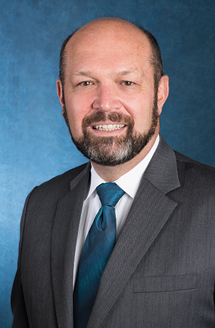March 2017—Students of history tell us that a durable paradigm shift most often involves a long gestation, typically under the radar and recognized by a precious few. What they frequently fail to tell us is that the vast majority of prognosticators often turn out to be both flat-out wrong and invisible when the “future” arrives. Either way, however, the prevailing narrative points to uncertainty in the greater health care environment. We have no choice but to process the changes we know are coming even if we don’t know where they are going. And we should do that from a foundation of strength and knowledge, because welcome or not, in the long run change is by definition disruptive.

Dr. Richard Friedberg
At the same time, we must ensure that our workplace is a safe space. To that end, it is sometimes helpful to acknowledge that the prospect of change can make people nervous, which creates its own persistent background hum of noise in the laboratory. Systems-based thinking is a critical skill. Especially when life gets complicated, we need to ensure that the laboratory setting is not distracting. When the drumbeat of current events, domestic drama, or other personal concerns threaten to distract, the steady pulse of shared purpose in a well-managed laboratory offers relief in the satisfaction of focused, meaningful, and process-oriented work.
Quality patient care in the laboratory calls for precision. We know that a small error can have tragic downstream consequences that persist long after today’s headlines are forgotten. For that reason, we collaborate through the CAP to protect the quality of our practice at the intersection of science and medicine.
When my laboratory teams find it difficult to leave the noise outside, we actively seek to underscore what they already know. That the quality of their attention is a critical element of patient safety. That CAP quality improvement tools—cancer checklists, protocols, Surveys, accreditation requirements, and so forth—are structural devices that shine a bright light on the value of accurate, reliable, and actionable results. That all of these things help us maintain a healthy rhythm, keep our eyes on the prize, and get it right. All of which are increasingly important in the pre- and postanalytic phases, as was made crystal clear in the 2015 Institute of Medicine (now National Academy of Medicine) report and recommendations on improving diagnosis in health care.
A critical error is a critical error, regardless of the number of beds, FTEs, or patients in the facility. Our duties as health care professionals apply equally to the first and last patient, whether there are 100 or 1,000 occupied patient beds in the facility. We scale up and down all day long to ensure that every test and procedure is done with the same attention to detail and follow-up. Vigilance is imperative because an undetected preanalytic labeling error can drive catastrophic consequences even if downstream processes are pristine. Diagnosis is a dynamic cognitive exercise. That is why it is not a paradox that laboratory findings can be 99 percent correct and 100 percent wrong at the same time.
However intense the pace, sound laboratory practices will create and sustain an environment that fosters our best work. Precision reassures; focus calms. With training and experience, pathologists and other laboratory professionals learn that each step in patient care presents its own risks. One small error can be a serial multiplier, transforming an overlooked step in the protocol into a dizzying array of dropping dominoes. So we make systems-based thinking contagious, double-checking ourselves and one another when stress is high and oversights more likely. All these steps make patients feel safer because they are, and that’s part of healing too.
When we are preoccupied by worrisome international news or a near-grown child’s adventures, there can be significant benefit in escaping to the rhythm of progress and accomplishment in a good day’s work. We are fortunate to have responsibilities that challenge our capabilities and give us something to focus on that is not related to matters beyond our control. That we can have a positive impact on so many people in the course of giving ourselves a mental health respite is a real benefit.
The larger meaning of our work is more apparent when we step outside the laboratory and into the patient care setting. Here, drama should be kept to a minimum. And here, too, error prevention can be a matter of life and death. But the distractions and demands of any given moment when patients are involved make it easy to see why what comes from the laboratory must be absolutely clear, concise, and concrete. A moment’s inattention or single hurried scribble can compromise specimen management at any point from vein to brain.
By thinking about how well we communicate with all clinical partners at their level of understanding and whether or not they are fluent in laboratory jargon, we contribute to cultural expectations of quality practice and individual responsibility for patient safety. Giving respectful consideration to the content and style of our communication signals to colleagues at every level that they are valued, which boosts their ability to keep patient safety in the foreground as well. Which is exactly where it should be.
[hr]
Dr. Friedberg would like to encourage every CAP member to attend the CAP Policy Meeting in Washington, DC, April 24–26. Two education-filled days on issues most important to pathologists will prepare CAP members for the annual Hill Day visits with legislators and their staff. One-on-one and small-group visits create powerful opportunities to establish rapport and talk frankly about the challenges facing physicians and their patients. Please see the CAP website for more information.
Dr. Friedberg welcomes communication from CAP members. Write to him at president@cap.org.